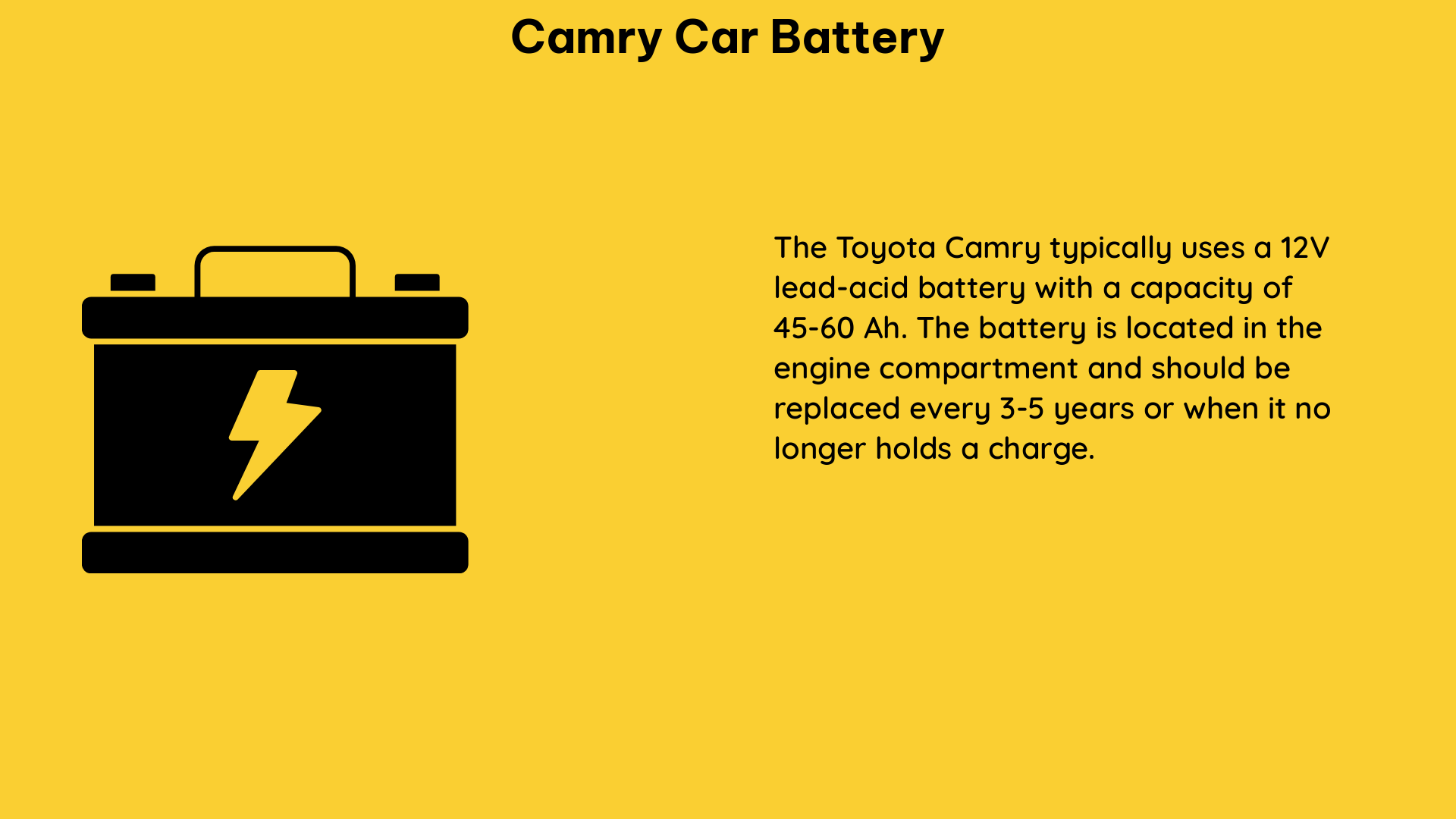The Toyota Camry is a popular and reliable sedan that has been a staple on the roads for decades. At the heart of this vehicle’s operation is the car battery, a crucial component that powers the electrical systems and ensures a smooth driving experience. Whether you own a standard gasoline-powered Camry or a hybrid model, understanding the intricacies of the car battery is essential for maintaining your vehicle’s performance and longevity.
Camry Car Battery: The Essentials
The battery in a Toyota Camry plays a vital role in the vehicle’s operation, providing the necessary power to start the engine, run the electrical components, and support the hybrid powertrain in the case of a Camry Hybrid. The battery’s group size, which refers to its physical dimensions and terminal configuration, is a crucial factor to consider when replacing the battery.
Battery Group Size: The Importance of Compatibility
The battery group size is a standardized classification system that helps ensure the replacement battery fits properly in the vehicle. For instance, a 1997 Camry V6 requires a battery group size of 35, which measures 10.25 inches in length, 6.81 inches in width, and 7.68 inches in height. However, some parts stores may suggest a smaller size like 24, which has higher Cold Cranking Amps (CCA) but is larger in dimensions, potentially causing fitment issues.
It’s essential to use the correct group size to ensure the battery fits securely in the designated battery tray and that the terminals align properly with the vehicle’s electrical system. Using an incompatible battery can lead to issues such as poor electrical connections, battery movement, and even damage to the vehicle’s components.
Camry Hybrid Battery: The AGM Advantage
In the case of a Camry Hybrid, the battery is a crucial component of the hybrid powertrain. These vehicles typically use an Absorbent Glass Mat (AGM) battery, which is designed to provide reliable power and withstand the demands of the hybrid system. The 2012-2017 Camry Hybrid, for example, utilizes a JIS D23 or JIS D26 factory 12-volt AGM battery, which is installed backward to ensure the proper positioning of the positive and negative terminals.
When replacing the battery in a Camry Hybrid, it’s essential to use an AGM battery with a vent hose connection and the correct group size. This ensures the replacement battery is compatible with the vehicle’s electrical system and can seamlessly integrate with the hybrid powertrain.
Identifying and Addressing Battery Issues

A dead or malfunctioning battery can manifest in various ways, such as a ticking noise, hesitation when starting the car, or flickering dashboard lights. In some instances, newer Camry models, like the 2020 SXE Camry, have experienced issues with their batteries draining due to software problems, with no immediate fix available.
Troubleshooting Battery Drain
If you’re experiencing battery drain issues with your Camry, it’s crucial to identify the root cause. This may involve checking for any software updates or recalls that could address the problem, as well as inspecting the battery terminals for corrosion or loose connections.
In the case of the 2020 SXE Camry, some owners have reported that the battery drain issue was caused by a software problem, which Toyota has yet to provide a permanent solution for. In such instances, it’s essential to stay informed about any updates or technical service bulletins from the manufacturer to ensure your vehicle is properly addressed.
Proper Battery Replacement Procedures
When it’s time to replace the battery in your Camry, whether it’s a standard gasoline model or a hybrid, it’s crucial to follow the correct procedures to ensure a successful installation. This includes:
- Identifying the correct battery group size for your Camry model and year.
- Selecting an AGM battery with the appropriate group size and terminal configuration for Camry Hybrid models.
- Properly disconnecting the old battery, ensuring the negative terminal is disconnected first.
- Cleaning the battery tray and terminal connections to prevent corrosion.
- Securely installing the new battery, ensuring it is properly positioned and the terminals are tightened.
- Resetting any necessary vehicle settings or systems, such as the clock or radio presets.
By following these steps, you can ensure a smooth and successful battery replacement process, maintaining the optimal performance and reliability of your Camry.
Conclusion
The Toyota Camry’s car battery is a vital component that deserves careful attention and maintenance. Understanding the importance of battery group size, the unique requirements of Camry Hybrid models, and the proper troubleshooting and replacement procedures can help you keep your Camry running at its best. By staying informed and proactive, you can ensure your Camry’s battery continues to provide reliable power and support the overall health of your vehicle.
References:
– Camry Hybrid Upgrade to Lithium, Installation Tips and Tricks and MPG – YouTube
– Battery Group Size? – Toyota Nation Forum
– Dead battery? – r/Camry – Reddit
– 2020 Camry battery going dead – Toyota Owners Club
– Update on 12 Volt Battery Replacement for Camry Hybrid 2012 – 2017 – Reddit

The lambdageeks.com Core SME Team is a group of experienced subject matter experts from diverse scientific and technical fields including Physics, Chemistry, Technology,Electronics & Electrical Engineering, Automotive, Mechanical Engineering. Our team collaborates to create high-quality, well-researched articles on a wide range of science and technology topics for the lambdageeks.com website.
All Our Senior SME are having more than 7 Years of experience in the respective fields . They are either Working Industry Professionals or assocaited With different Universities. Refer Our Authors Page to get to know About our Core SMEs.